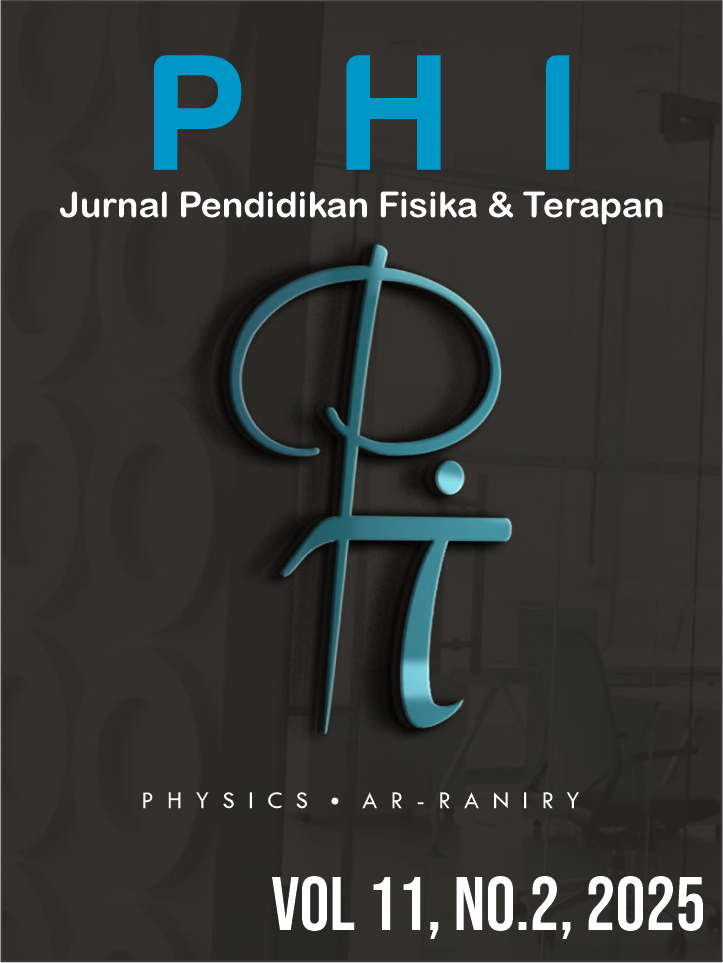Creative Thinking Ability of MTs Students on the Topic of Renewable Energy: A Case Study in South OKU
DOI:
https://doi.org/10.22373/by0md956Keywords:
Creative Thinking, TTCT, Torrance Test, Renewable Energy, MTsAbstract
This study aims to analyse the creative thinking ability of MTs students in South OKU Regency on renewable energy material. The research sample totalled 109 ninth grade students from four MTs selected by purposive sampling. The research instrument was in the form of multiple choice questions based on TTCT (Torrance Tests of Creative Thinking) indicators consisting of fluency, flexibility, originality, and elaboration. The results showed that the average score in the range of 100 students' creative thinking ability was 41.56. The average score of each indicator is: fluency (60.54), elaboration (45.77), flexibility (32.03), and originality (22.52). The highest average score is on the fluency indicator and the lowest score is on the originality indicator. This shows that students do not have difficulty in generating many ideas, but still have difficulty in generating unique and innovative ideas. The results of this study provide a factual picture of the condition of the creative thinking skills of MTs.
References
Akhsan, H., Wiyono, K., Ariska, M., & Melvany, N. E. (2020). Development of HOTS (higher order thinking skills) test instruments for the concept of fluid and harmonic vibrations for high schools. Journal of Physics: Conference Series, 1480(1). https://doi.org/10.1088/1742-6596/1480/1/012071
Akhsan, H., Wiyono, K., Ariska, M., & Melvany, N. E. (2020). Development of Higher-order Thinking Test Instrument on Fluid Material for Senior High School Students. Journal of Physics: Conference Series, 1467(1). https://doi.org/10.1088/1742-6596/1467/1/012046
Alabbasi, A. M. A., Paek, S. H., Kim, D., & Cramond, B. (2022). What do educators need to know about the Torrance Tests of Creative Thinking: A comprehensive review. Frontiers in psychology, 13, 1000385. https://doi.org/10.3389/fpsyg.2022.1000385
Adriani, R., Safriana, S., Ginting, F. W., Muliani, M., & Widya, W. (2025). Application Of The Project Based Learning (PjBL) Model Assisted By Augmented Reality To Increase Student Creativity On Solar System Material. Phi: Jurnal Pendidikan Fisika dan Terapan, 11(2), 123-235. https://doi.org/10.22373/ca90br27
Asilevi, M.N., Kärkkäinen, S., Sormunen, K., & Havu-Nuutinen, S. (2024). A comparison of science learning skills in the teacher-centered approach and inquiry-based science fieldwork: Primary school students' perceptions. International Journal of Education in Mathematics, Science, and Technology (IJEMST), 12(1), 1-19. https://doi.org/10.46328/ijemst.3146
Bayani, F., Rokhmat, J., Hakim, A., & Sukarso, A. A. (2025). Research trends in analytical thinking skills for science education: insights, pedagogical approaches, and future directions. International Journal of Ethnoscience and Technology in Education, 2(1), 129-157. https://doi.org/10.33394/ijete.v2i1.14142
Boone, W. J., Yale, M. S., & Staver, J. R. (2014). Rasch analysis in the human sciences. In Rasch Analysis in the Human Sciences. https://doi.org/10.1007/978-94-007-6857-4
Creswell, J. W., & Poth, C. N. (2016). Qualitative inquiry and research design: Choosing among five approaches. Sage publications.
Creswell, J. W., & Clark, V. L. P. (2017). Designing and conducting mixed methods research. Sage publications.
Csikszentmihalyi, M. (1997). Flow and the psychology of discovery and invention. HarperPerennial, New York, 39, 1-16. https://www.rochester.edu/warner/lida/wp-content/uploads/2022/11/creativity-by-mihaly-csikszentmihalyi.pdf
Ellianawati, E., Subali, B., Putra, B. R., Wahyuni, S., Dwijananti, P., Adhi, M. A., & Yusof, M. M. M. (2025). Critical thinking and creativity in STEAM-based collaborative learning on renewable energy issues. Journal of Education and Learning (EduLearn), 19(1), 112-119. https://doi.org/10.11591/edulearn.v19i1.21638
Fideli, H., & Aliazas, J. V. (2022). Enhancing collaboration and creative thinking skills through technology preparedness in a mixed learning environment. International Journal of Educational Management and Development Studies, 2(4), 43-60. https://doi.org/10.53378/352927
Gryazeva-Dobshinskaya, V.G., Korobova, S.Y., Dmitrieva, Yu.A., Glukhova, V.A., Koltunov, E.I. (2025). Generalised Factors of Creative Thinking in the Context of Diversity of Subjects’ Socio-Cultural Identity. Social Psychology and Society, 16(1), 28–50. (In Russ.). https://doi.org/10.17759/sps.2025160102
Holechek, J. L., Geli, H. M., Sawalhah, M. N., & Valdez, R. (2022). A global assessment: can renewable energy replace fossil fuels by 2050?. Sustainability, 14(8), 4792. Available from: https://doi.org/10.3390/su14084792
Isabirye, A. ., Moloi, K. ., Lebelo, R. ., & Khan, S. . (2025). Cultivating Creativity and Innovation in the School Curriculum for the 21st Century: Opportunities and Challenges. Journal of Ecohumanism, 4(3), 334 –. https://doi.org/10.62754/joe.v4i3.6647
Larraz-Rábanos, N. (2021). Development of Creative Thinking Skills in the Teaching-Learning Process. IntechOpen. https://doi.org/10.5772/intechopen.97780
Leasa M, Batlolona JR, Talakua M. (2021). Elementary students’ creative thinking skills in science in the Maluku islands, Indonesia. Creat Stud, 14(1):74–89. Available from: https://doi.org/10.3846/cs.2021.11244
Leasa, M., Papilaya, P. M., Batlolona, J. R., & Nuniary, S. (2023). Project-based learning: changing Students’ Scientific Thinking to Be Creative from Waste Natural Materials. Jurnal Penelitian Pendidikan IPA, 9(1), 350–359. https://doi.org/10.29303/jppipa.v9i1.2459
Lestari, R., & Lingga, L. J. (2024). Factors analysis inhibiting elementary school students’ creative thinking in learning science and social subject. ELSE (Elementary School Education Journal): Jurnal Pendidikan Dan Pembelajaran Sekolah Dasar, 8(3). https://doi.org/10.30651/else.v8i3.24408
Mullis, I. V., Martin, M. O., Foy, P., Kelly, D. L., & Fishbein, B. (2020). TIMSS 2019 international results in mathematics and science.
Nurfa, N. N., & Nana. (2020). Pengaruh Model Project Based Learning Terintegrasi 21st Century Skills Terhadap Kemampuan Berpikir Kreatif Siswa SMA Fisika. Jurnal Penelitian Pendidikan Fisika, 5(2), 109–115. http://ojs.uho.ac.id/index.php/JIPFI
OECD. (2023). PISA 2022 results (Volume III): Creative minds, creative schools (Factsheets: Indonesia). OECD Publishing. https://doi.org/10.1787/765ee8c2-en
Østergaard, P. A., Duic, N., Noorollahi, Y., Mikulcic, H., & Kalogirou, S. (2020). Sustainable development using renewable energy technology. Renewable energy, 146, 2430-2437. https://doi.org/10.1016/j.ijft.2021.100123
Permadi, D., Antika, R. N., Anggreini, A., Hilmalia, Y., & Yulandari, A. (2025). Project Based Learning in Science Education Research in Indonesia: A Bibliometric Analysis. Phi: Jurnal Pendidikan Fisika dan Terapan, 11(2). https://doi.org/10.22373/p-jpft.v11i2.29885
Putri, R. K., Bukit, N., & Simanjuntak, M. P. (2021). The Effect of Project Based Learning Model ’ s on Critical Thinking Skills , Creative Thinking Skills , Collaboration Skills , & Communication Skills (4C) Physics in Senior High School. Proceedings of the 6th Annual International Seminar on Transformative Education and Educational Leadership (AISTEEL 2021), 591, 323–330. https://doi.org/10.2991/assehr.k.211110.103
Rabaia, M. K. H., Abdelkareem, M. A., Sayed, E. T., Elsaid, K., Chae, K. J., Wilberforce, T., & Olabi, A. G. (2021). Environmental impacts of solar energy systems: A review. Science of The Total Environment, 754, 141989. Available from: https://doi.org/10.1016/j.scitotenv.2020.141989
Setyarini, T. A., Mustaji, & Jannah, M. (2020). The Effect of Project-Based Learning Assisted PANGTUS on Creative Thinking Ability in Higher Education. International Journal Pf Emerging Technologies in Learning (IJET), 15(11), 245–251. https://doi.org/10.3991/ijet.v15i11.12717
Sternberg, R. J. (1999). Handbook of Creativity. Cambridge University Press.
Szeberényi, A., Rokicki, T., & Papp-Váry, Á. (2022). Examining the Relationship between Renewable Energy and Environmental Awareness. Energies, 15(19), 7082. https://doi.org/10.3390/en15197082
Ulazia, A., & Ibarra-Berastegi, G. (2020). Problem-based learning in university studies on renewable energies: Case of a laboratory windpump. Sustainability, 12(6), 2495. Available from: https://doi.org/10.3390/su12062495
Wiyono, K., Sury, K., Hidayah, R. N., Nazhifah, N., Ismet, I., & Sudirman, S. (2022). STEM-based E-learning: Implementation and effect on communication and collaboration skills on wave topic. Jurnal Penelitian & Pengembangan Pendidikan Fisika, 8(2), 259-270. https://doi.org/10.21009/1.08208
Wiyono, K., Zulkardi, Madang, K., Suhery, T., Yusup, M., Effendi, ... & Shahrill, M. (2024). The preliminary prototype of learning material based on STEM framework in renewable energy topic. In AIP Conference Proceedings (Vol. 3052, No. 1, p. 020053). AIP Publishing LLC. https://doi.org/10.1063/5.0201402
Zulkarnaen, Z., Suhirman, S., Hidayat, S., Prayogi, S., Sarnita, F., Widia, W., ... & Verawati, N. N. S. P. (2022). The Effect of Problem Based Learning Model on Students' Creative Thinking Ability. Jurnal Penelitian Pendidikan IPA, 8(1), 379-382. https://doi.org/10.29303/jppipa.v8i1.1307
Downloads
Published
Issue
Section
License
Copyright (c) 2025 Mega Kurnia, Ketang Wiyono, Hamdi Akhsan, Ismet

This work is licensed under a Creative Commons Attribution-NonCommercial 4.0 International License.
Authors who publish with Jurnal Phi agree to the following terms:
- Authors retain copyright and grant the journal right of first publication with the work simultaneously licensed under a Creative Commons Attribution License (CC BY 4.0) that allows others to share the work with an acknowledgment of the work's authorship and initial publication in this journal.
- Authors are able to enter into separate, additional contractual arrangements for the non-exclusive distribution of the journal's published version of the work (e.g., post it to an institutional repository or publish it in a book), with an acknowledgment of its initial publication in this journal.
- Authors are permitted and encouraged to post their work online (e.g., in institutional repositories or on their website) prior to and during the submission process, as it can lead to productive exchanges, as well as earlier and greater citation of published work (See The Effect of Open Access).

















